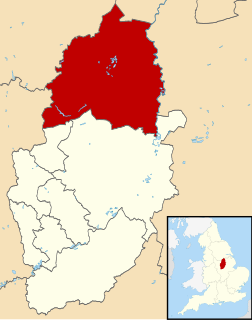| Clowne | |
|---|---|
 Clowne Rural District shown within Derbyshire in 1970. | |
| History | |
| • Created | 1894 |
| • Abolished | 1974 |
| • Succeeded by | Bolsover |
| Status | Rural district |
| Government | Clowne Rural District Council |
Clowne was a rural district in Derbyshire, England from 1894 to 1974.
Rural districts were a type of local government area – now superseded – established at the end of the 19th century in England, Wales, and Ireland for the administration of predominantly rural areas at a level lower than that of the administrative counties.

Derbyshire is a county in the East Midlands of England. A substantial portion of the Peak District National Park lies within Derbyshire, containing the southern extremity of the Pennine range of hills which extend into the north of the county. The county contains part of the National Forest, and borders on Greater Manchester to the northwest, West Yorkshire to the north, South Yorkshire to the northeast, Nottinghamshire to the east, Leicestershire to the southeast, Staffordshire to the west and southwest and Cheshire also to the west. Kinder Scout, at 636 metres (2,087 ft), is the highest point in the county, whilst Trent Meadows, where the River Trent leaves Derbyshire, is its lowest point at 27 metres (89 ft). The River Derwent is the county's longest river at 66 miles (106 km), and runs roughly north to south through the county. In 2003 the Ordnance Survey placed Church Flatts Farm at Coton in the Elms as the furthest point from the sea in Great Britain.

England is a country that is part of the United Kingdom. It shares land borders with Wales to the west and Scotland to the north-northwest. The Irish Sea lies west of England and the Celtic Sea lies to the southwest. England is separated from continental Europe by the North Sea to the east and the English Channel to the south. The country covers five-eighths of the island of Great Britain, which lies in the North Atlantic, and includes over 100 smaller islands, such as the Isles of Scilly and the Isle of Wight.
It was created by the Local Government Act 1894 as that part of the Worksop rural sanitary district which was in Derbyshire (the rest becoming either Worksop Rural District or Kiveton Park Rural District). It consisted of four civil parishes :

The Local Government Act 1894 was an Act of the Parliament of the United Kingdom that reformed local government in England and Wales outside the County of London. The Act followed the reforms carried out at county level under the Local Government Act 1888. The 1894 legislation introduced elected councils at district and parish level.

Worksop is the largest town in the Bassetlaw district of Nottinghamshire, England. Worksop lies on the River Ryton, and is located at the northern edge of Sherwood Forest. Worksop is located 19 miles (31 km) east-south-east of Sheffield, with a population of 41,820.

Worksop was a Rural District in Nottinghamshire, England.
It was abolished in 1974 under the Local Government Act 1972, going on to form part of the new district of Bolsover.

The Local Government Act 1972 is an Act of the Parliament of the United Kingdom that reformed local government in England and Wales on 1 April 1974.







